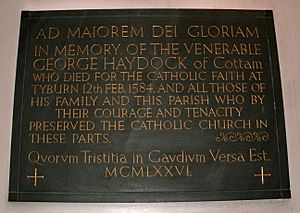Eighty-five martyrs of England and Wales facts for kids
Quick facts for kids George Haydock and Eighty-four Companion Martyrs |
|
|---|---|

Plaque honouring Haydock in the church of St. Andrew's & Blessed George Haydock, Cottam, Lancashire.
|
|
| Died | Between 11 January 1584 (William Carter (martyr)) - 12 August 1679 (Charles Mahoney), within England and Wales |
| Venerated in | Roman Catholic Church |
| Beatified | 22 November 1987, by Pope John Paul II |
| Feast | 4 May, 22 November, various for individual martyrs |
| Attributes | martyr's palm knife in chest noose in neck book or bible crucifix chaucible Eucharist various religious habits crown of martyrdom |
The Eighty-five Martyrs of England and Wales were a group of people who faced difficult times because of their religious beliefs. They are also known as George Haydock and Eighty-four Companion Martyrs. These individuals were put to death in England between 1584 and 1679.
Most of them, seventy-five out of eighty-five, were executed under a law called the Jesuits, etc. Act 1584. The Roman Catholic Church considers them martyrs, meaning they died for their faith. They were officially recognized as "Blessed" (a step towards sainthood) on 22 November 1987 by Pope John Paul II.
Contents
Who Were the Eighty-five Martyrs?
This group includes priests and ordinary people. They were chosen from many Catholics who died between 1584 and 1679. Here are their names:
- John Adams
- Thomas Atkinson
- Edward Bamber
- George Beesley
- Arthur Bell
- Thomas Belson
- Robert Bickerdike
- Alexander Blake
- Marmaduke Bowes
- John Britton
- Thomas Bullaker
- Edward Burden
- Roger Cadwallador
- William Carter
- Alexander Crow
- William Davies
- Robert Dibdale
- George Douglas
- Robert Drury
- Edmund Duke
- George Errington
- Roger Filcock
- John Fingley
- Matthew Flathers
- Richard Flower
- Nicholas Garlick
- William Gibson
- Ralph Grimston
- Robert Grissold
- John Hambley
- Robert Hardesty
- George Haydock
- Henry Heath
- Richard Hill
- John Hogg
- Richard Holiday
- Nicholas Horner
- Thomas Hunt
- Thurstan Hunt
- Francis Ingleby
- William Knight
- Joseph Lambton
- William Lampley
- John Lowe
- Robert Ludlam
- Charles Mahoney
- Robert Middleton
- George Nichols
- John Norton
- Robert Nutter
- Edward Osbaldeston
- Anthony Page
- Thomas Palasor
- William Pike
- Thomas Pilchard
- Thomas Pormort
- Nicholas Postgate
- Humphrey Pritchard
- Christopher Robinson
- Stephen Rowsham
- John Sandys
- Montford Scott
- Richard Sergeant
- Richard Simpson
- Peter Snow
- William Southerne
- William Spenser
- Thomas Sprott
- John Sugar
- Robert Sutton
- Edmund Sykes
- John Talbot
- Hugh Taylor
- William Thomson
- Robert Thorpe
- John Thules
- Edward Thwing
- Thomas Watkinson
- Henry Webley
- Christopher Wharton
- Thomas Whittaker
- John Woodcock
- Nicholas Woodfen
- Roger Wrenno
- Richard Yaxley
When Are They Remembered?
In England, these martyrs have a special day to remember them. This day is called a feast day and it is on 4 May. On this day, they are honored along with other martyrs who were recognized between 1886 and 1929. The Forty Martyrs of England and Wales, who are considered saints, are also remembered on this day since the year 2000.
In Wales, 4 May specifically honors the martyrs from England and Wales who were declared "Blessed." Some of the 85 martyrs had connections to Wales. These include William Davies, Humphrey Pritchard, and Charles Mahoney. Two others, William Gibson and George Douglas, had Scottish connections. In Wales, 25 October is still a separate feast day for the 'Six Welsh Martyrs and their companions'.
Why Were They Persecuted?
During the time of Queen Elizabeth I, there was a lot of tension. The Pope, Pope Pius V, declared that Queen Elizabeth I was no longer part of the Catholic Church in 1570. This created a difficult situation for English Catholics.
Some Catholics felt they had to oppose Queen Elizabeth. Others, however, wanted to remain loyal to the Queen while still practicing their Catholic faith. The government saw any opposition as a serious threat to the country.
The next Pope, Gregory XIII, later said that Catholics did not have to actively go against the Queen. Most English Catholics tried to show their loyalty. However, they still wanted to practice their religion, which was becoming very difficult.
New laws were passed that made it very risky to be Catholic. For example, a law in 1571 made it a serious crime to bring any message from the Pope into England. It also became a crime to help someone become Catholic again. These religious actions were seen as acts against the government.
Queen Elizabeth's government did not always separate those who actively rebelled from those who simply wanted to practice their faith. They often treated all Catholics as if they were disloyal.
A government official, Lord Burghley, wrote a pamphlet. He claimed that Catholic priests coming to England were not doing it for religious reasons. He said they were trying to get people to follow the Pope's orders against the Queen.
Later, in 1585, another law made it a serious crime for any seminary priest or Jesuit to even enter England. It was also a crime to help or shelter them. Lord Burghley argued that before the Pope's declaration, no one was punished for their religion. He said everything changed because of the Pope's actions. The government even created "bloody questions." These were questions designed to test people's loyalty to the Queen. If you answered them in a way that showed loyalty to the Pope over the Queen, you could be in serious trouble.
See also

